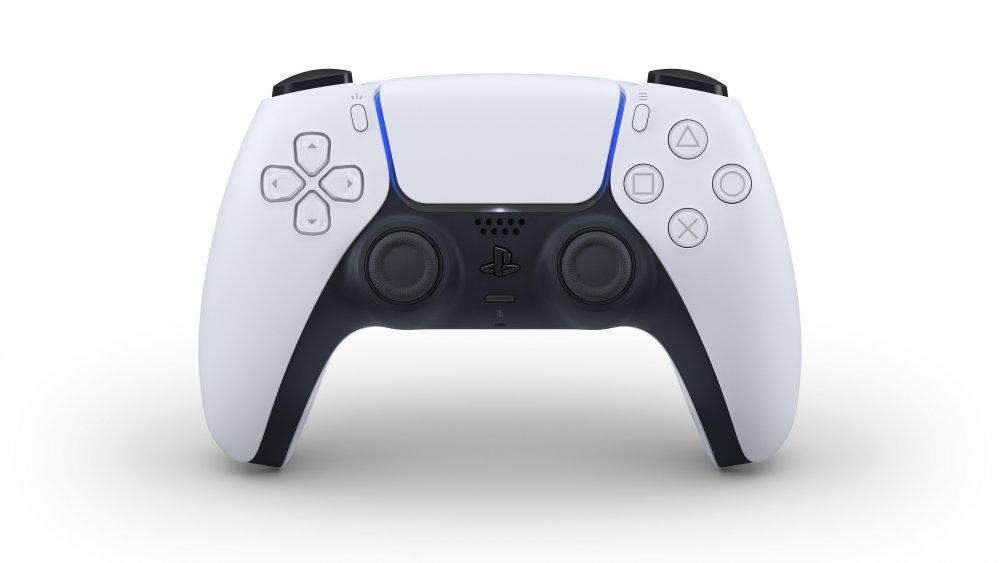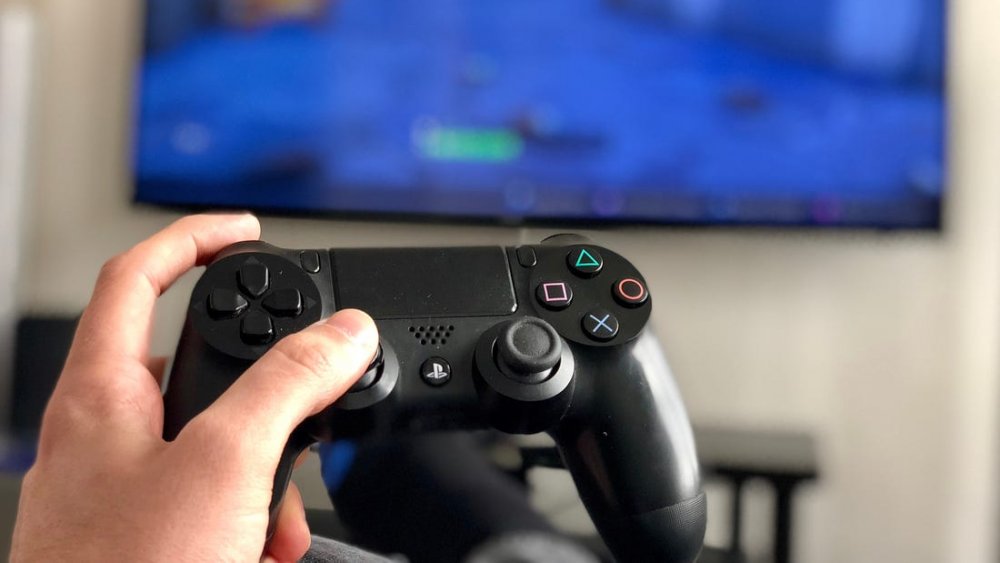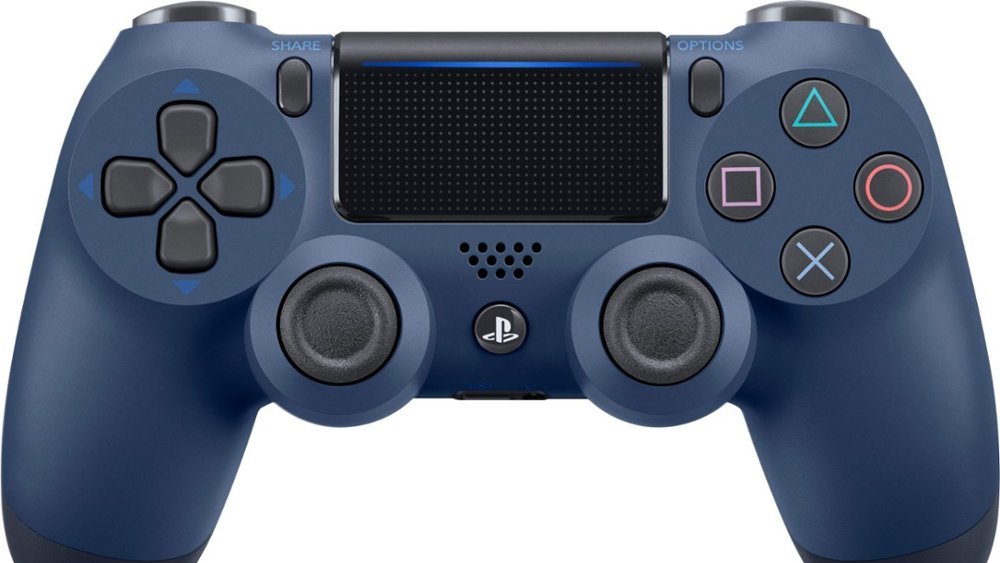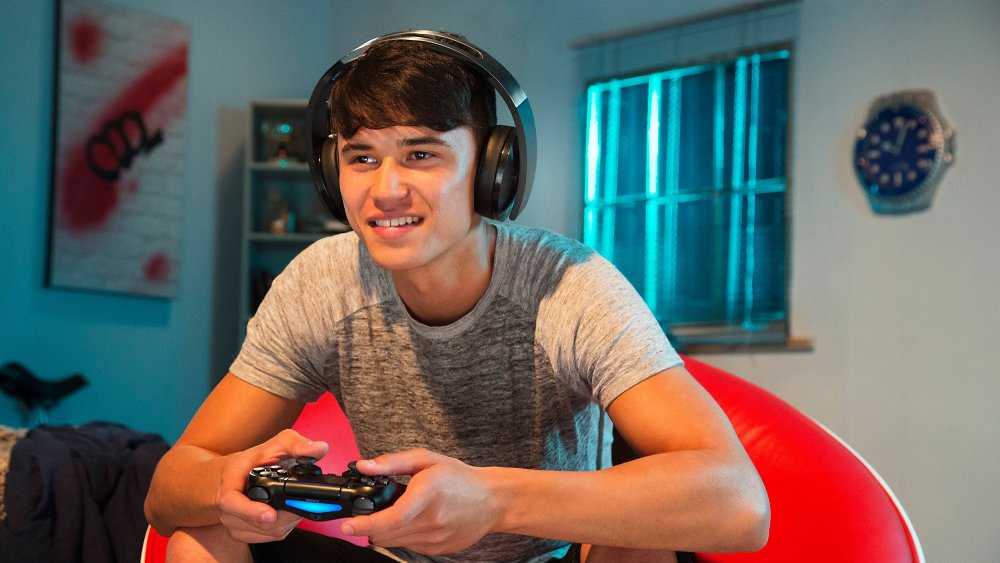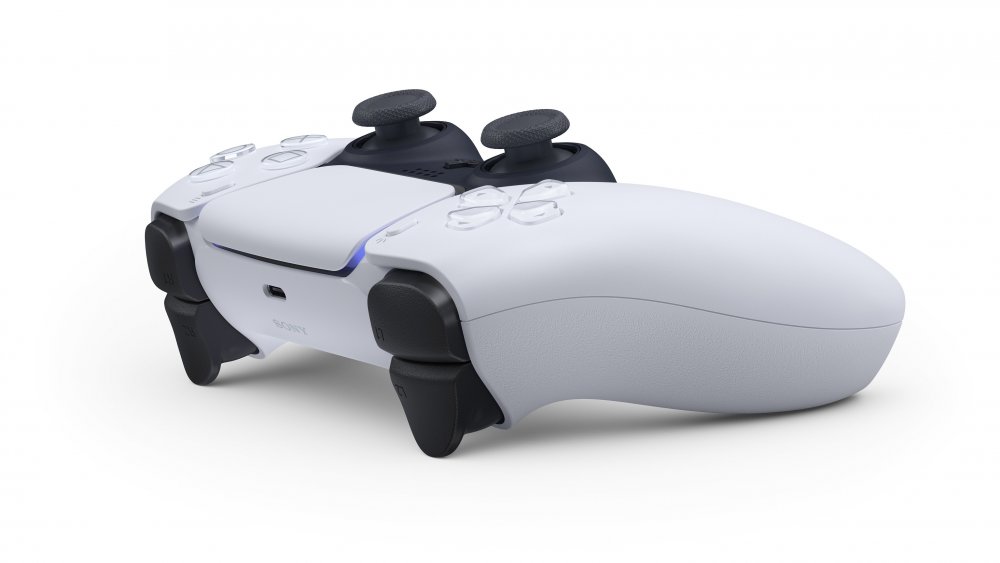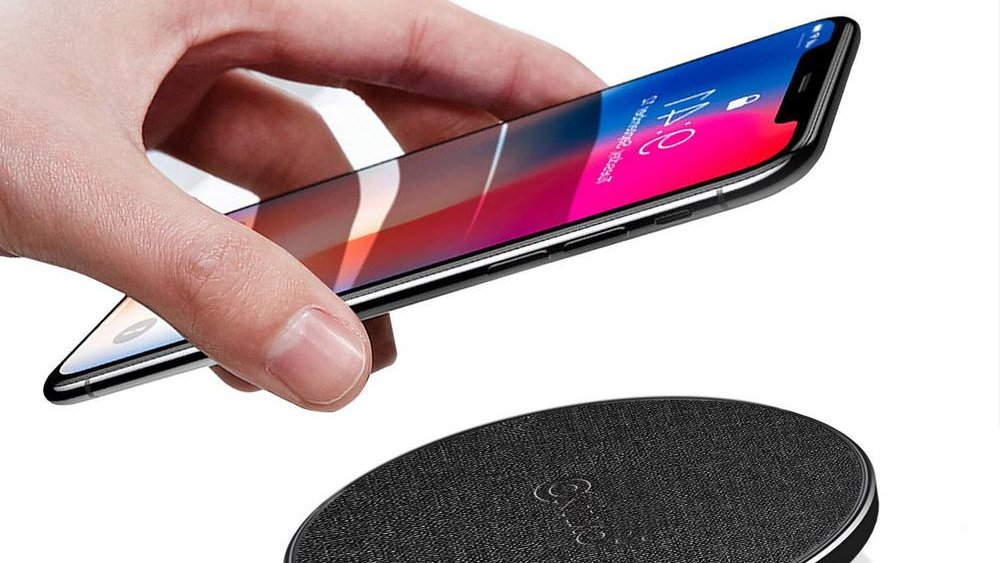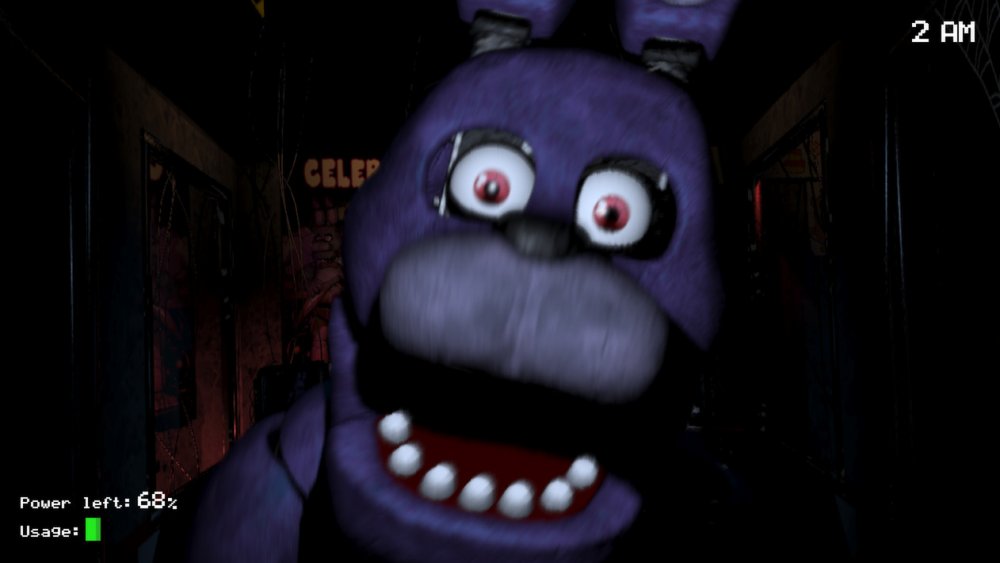What The PS5's DualSense Controller Means For Gaming
While Sony has yet to unveil the PlayStation 5, the company was more than happy to show off the upcoming console's controller. Unlike other iterations that share the same basic shape, black color scheme, and DualShock name, the latest iteration on the PlayStation gamepad breaks with tradition. The new controller, named the DualSense, sports a sleek and futuristic design, as well as a two-tone color scheme. The controller's under-the-hood features also set it apart from past PlayStation controllers and make it a figurative and literal game changer.
While the DualSense's true capabilities remain a mystery, Sony has revealed enough information to paint a decent picture of its priorities with controllers going forward. If Sony plays its cards right, the DualSense could represent the future of console gaming.
Haptic feedback means more player immersion
In the past, Sony's DualShock controllers came with twin vibration motors that provided decent rumble feedback. Now, the company is upping its game with haptic feedback motors. Similar to the HD rumble found in Nintendo Switch Joy-Cons, the DualSense will provide tons of tactile sensations such as the "slow grittiness of driving a car through mud."
Imagine, for instance, playing the legendary Uncharted 4 chase scene on the PS5 with the DualSense controller. Haptic feedback could dynamically and seamlessly change with the action. Hypothetically, players could feel truck tires skid on pavement and slide through mud, all thanks to the DualSense's high-tech rumble motors.
Given the Nintendo Switch's HD rumble, the Xbox Series X's trigger motors, and the PS5's haptic feedback, unprecedented tactile sensation is the name of the game going forward. Hardware engineers clearly want to improve player immersion with rumble motors that utilize tactile feedback unlike anything felt in the past. The DualSense is probably the first in a long line of PlayStation controllers that will provide unique rumble mechanics.
Triggers could tangibly increase a game's difficulty in more ways than one
The DualSense controller's key design philosophy is letting players feel the literal weight of their actions. One feature Sony will use to incorporate this idea is adaptive triggers, which will provide tangible tension when, for example, players draw back the string on a bow.
Sony's DualSense announcement didn't elaborate on the capabilities of the adaptive triggers, but you can read between the lines to interpret Sony's desires. The triggers could add a new form of difficulty to games. Take the bow example from the reveal. In many modern games, bows aren't as fast as guns and are affected by external ballistics (i.e., how gravity/game physics affect projectile trajectory). In theory, the DualSense could increase game difficulty by forcing players to press down even harder on the trigger while using a bow, as well as making it difficult to keep the button depressed the longer it is held. Have you ever tried keeping a bowstring taut over a long period of time? It's not easy.
If the DualSense's adaptive triggers are a success, future game developers could implement new tactile difficulty modes that wear down players through reactive triggers. Nothing puts a gamer in the shoes of a survivor quite like simulating the stress of drawing back a bowstring.
From merely sharing content to creating content
Content creation is now easier than ever before. PCs have numerous apps that let people stream gameplay sessions, while the PlayStation 4 and Nintendo Switch feature buttons dedicated to sharing epic screenshots and video clips. Even Microsoft is joining the content creation scene with a share button in the middle of the Xbox Series X's controller. However, Sony is upping the ante with the DualSense's "Create" button. At least, that's what is probably happening.
The DualSense's Create button will replace the DualShock 4's Share button. According to Sony, the Create button will "[pioneer] new ways for players to create epic gameplay content to share with the world." The statement might imply Sony plans to ship the PS5 with a pre-installed content creation suite. If so, the barrier of entry for creating gaming clips and streams could very well disappear. Instead of using capture cards or recording equipment, players could just press the Create button and let their console do the heavy lifting.
Granted, this interpretation is pure speculation based on vague wording. If Sony is implementing a push-button solution for game streaming and recording, however, the PlayStation 5 could potentially be the first in a long line of consoles — including rival consoles — that come packaged with pre-installed content creation software that only requires one button press. Sure, the PS4 and Xbox One come with SHAREfactory and Upload Studio, respectively, but those require some basic video editing software knowledge. The DualSense's Create button might make the process a little bit easier.
The monetary barrier for communication just decreased
Multiplayer gaming has exploded in popularity thanks to games like Fortnite and Apex Legends, but effective communication remains a barrier for these titles. In order to chat with friends on consoles, your best option is specialized headsets that can cost upwards of $50. You can use the earbud/mic combo that comes packaged with the PlayStation 4, but it's pretty janky and barely worth the hassle. Lucky for you, the DualSense controller will solve your multiplayer communication woes.
Much like the DualShock 4, the DualSense will feature a speaker as well as a built-in microphone. Unlike other features that are designed for player immersion, the microphone is meant specifically to let players chat without a headset. While Sony recommends headsets for prolonged gaming sessions, players on a budget can just use the DualSense for all their multiplayer communication needs.
While the gaming headset market won't disappear anytime soon, the DualSense's microphone could pave the way for more all-in-one controllers that preclude the need for a headset, or at least let players chat with friends while their headset is in the mail. Either way, the DualSense removes one more communication barrier that plagues console multiplayer aficionados.
Sony is doubling down on the touchpad
One of the DualShock 4's biggest features — figuratively and literally — was the touchpad. This big, touch-sensitive black bar was supposed to give PS4 games unique control schemes. While titles such as Tearaway Unfolded and Infamous: Second Son properly utilized the pad, other games just used it as a giant, glorified map/menu button. Love it or hate it, the DualSense will feature an even bigger touchpad.
Sony clearly doesn't want to abandon its precious touchpad, and it will be bigger than ever on the DualSense. However, the pad's utilization will depend on developers. Studios might get more use out of the pad this time around, or maybe it will once again fade into the background.
The PS5 could either make or break Sony's touchpad gamble. Either the pad will catch its second wind and see a resurgence in popularity, or it will go the way of the Dodo and the Kinect. Nevertheless, the DualSense will potentially determine if the PS6's controller features a touchpad.
Controller prices might skyrocket
The DualSense sounds like a game changer thanks to its bevy of features. However, the technology behind the controller's additions sound expensive. While Sony has not confirmed the DualSense's price, odds are good it will make the wallets of gamers cry out in pain.
Sites such as TechRadar predict the DualSense will sell for around $70. That's pretty high if true, but not outside the realm of possibility. After all, the PlayStation 4's DualShock 4 controllers are already very pricy — $60 to $65 — even though they don't include haptic feedback or adaptive triggers. Plus, the Nintendo Switch Pro and Joy-Con controllers cost $70 and $80, respectively, thanks to their HD rumble and NFC reader features. If TechRadar is on the money with its prediction, then we might see prices increase even more as technology is added to future consoles and controllers.
All is not lost, however, as expensive controllers open the door for third-party companies to release budget-friendly alternatives. PowerA, for example, sells Switch Pro controllers that lack rumble, an NFC reader, and rechargeable batteries for only $25 to $50. If the DualSense is expensive, perhaps PowerA or other companies might sell DualSense substitutes that trade features for lower prices. The same could apply to future controllers, as well.
You might not need the DualSense controller at all
Whenever you buy a new console, it always comes with one new controller. However, if you want to play some couch co-op — or just want a controller in a fancy color — you have to shell out money for another controller. You can't use your old Xbox 360 controller to play games on the Xbox One, and you certainly can't use DualShock 2 controllers with the PlayStation 3. This holds true for most consoles, but the PlayStation 5 might break that trend.
According to a rumor floated by sites such as TechRadar and RespawnFirst, DualShock 4 controllers might be compatible with the PlayStation 5. While this is just a rumor, it would mark the first time Sony's offered backwards controller compatibility if true. So far, only Nintendo provides limited backwards controller compatibility, most notably for the Gamecube controller. There's no better way to play Super Smash Bros., after all. Microsoft, meanwhile, plans to support Xbox One accessories on Xbox One X, which could explain Sony's eagerness to do the same with the DualShock 4.
If PlayStation 5 lets players use their old DualShock 4 controllers, we could potentially see more backwards controller compatibility in future consoles to go along with the ever-popular backward compatibility with games. No longer would gamers have steadily growing collections of obsolete controllers that gather dust.
More bells and whistles, less weight
The DualSense controller is packed to the gills with gizmos and gadgets. Haptic feedback motors, adaptive triggers, a built-in microphone, and a rechargeable battery are stuffed into the controller's tiny frame. It's only natural to assume the DualSense could be used as a makeshift dumbbell given everything that's crammed into it, but that's not the case.
Apparently, Sony is trying to minimize the DualSense's heft. While Sony has yet to unveil the DualSense's actual weight, the controller announcement implies that hardware engineers — especially Sony — are approaching a technological singularity where factors such as size and mass are no longer obstacles. Then again, Sony has a history of balancing function with weight. The PlayStation 3's original Sixaxis controller weighs 137 grams (0.3 pounds), while the DualShock 3, which adds rumble, weighs 192 grams (0.4 pounds). Meanwhile, the DualShock 4 crams all the DualShock 3's features, as well as a touchpad, speaker, and lightbar into a smaller shell and only weighs 210 grams (0.46 pounds).
For game controllers, more is now less in the best way possible. In the future, expect engineers to pack even more features into lightweight controllers.
USB-C you later, micro USB
Even though rechargeable batteries are the norm for handheld devices and game controllers (except Xbox, for some reason), companies use different cords to charge these items. Some consoles, such as the Nintendo 3DS and Wii U pad, utilize specialized cables that don't work with other gadgets, while others like the DualShock 4 controller were developed with enough forethought to utilize micro USB. Apparently, the DualSense will also use universal cables, but of a speedier variety.
If you examine screenshots of the DualSense controller, you will notice a small USB port in the front. According to TechRadar, it is a USB-C port. This change makes sense since USB-C is faster than micro USB and is the go-to plug for modern technology that gluttonously consume battery power, including smartphones and Nintendo Switch peripherals. Since the DualSense crams more technology into its frame, the controller requires a beefier battery to keep everything running. A micro USB won't cut it for the DualSense, hence the switch to the faster USB-C
Until someone invents an even speedier USB cable, USB-C will probably be used to quickly charge the batteries of power-hungry game controllers.
Voice recognition could make a comeback
While the DualSense controller's features focus on player immersion, its built-in microphone offers more potential, especially given one of Sony's most recent patents.
Eagle-eyed members of SegmentNext discovered a patent for a "controller device that is held in a user's hand, and includes a microphone, a tactile sense presentation device that presents a tactile sense to the user's hand, and a speaker." Sounds like a DualSense, no? Well it gets better since the patent explains how the controller will monitor its user's voice. The controller's microphone and speaker will apparently prevent playback echoes while players chat. But more importantly, the patent also includes a hypothetical situation where, in layman's terms, the controller will utilize voice commands to attack in-game enemies.
Assuming this patent applies to the DualSense's microphone, we might see voice command functionality implemented in future game controllers. After all, voice recognition technology has advanced by leaps and bounds, as demonstrated by devices such as Alexa and Siri. Why not implement the tech in controllers with built-in microphones?
No charging cord? No problem
While the USB-C is the default charging cord for most modern gadgets, the latest big feature in the world of batteries is wireless charging. Why connect a phone to a cable when you can place it on a platform instead? Relatively few phones utilize wireless charging, but Sony might plan to use this technology in its DualSense controller.
Sony filed a fairly recent patent that outlines a "wireless charging adapter (212) that can snap onto a computer game controller (200) can be inductively coupled to a charging base (230) to wirelessly recharge a battery (204) in the controller (200)." The patent states the adapter is "able to charge and/or interact with a multitude of electronic devices," but it uses the DualShock 4 for illustrative examples,
To be fair, patents are not a guarantee of future products or features, but the timing of Sony's patent is suspect given the recent DualSense announcement. Perhaps Sony plans to implement wireless charging in the DualSense, or maybe the company is already developing the DualSense 2.0 to charge wirelessly. Alternatively, maybe Sony won't ever implement the patented technology. If Sony added wireless charging to the DualSense, though, the company could pave the way for a fully cordless future as far as controllers go.
Games could change depending how much they stress you
Sony has been on a patent filing binge. The company not only patented a voice-controlled and wireless charging controller, but also a controller with a "biofeedback sensor attachment." The sensors in the attachment, according to the patent, measure factors such as sweat production (i.e., if a game makes you sweat buckets) and "tailor content" depending on those elements.
While the patent uses the DualShock 4 as an example, it was filed almost two months before the DualSense reveal. Nobody can say for sure if the patented technology was meant to be announced later or if Sony is merely toying with the idea. However, if Sony hypothetically combined haptic feedback motors with biofeedback sensors, the result could give the name "DualSense" a whole new meaning.
If biofeedback sensors make their way into the DualSense controller, they could open up new avenues for console games. Imagine a horror title that becomes more difficult as your heart races and sweat increases. Actually, you don't need to imagine because Nevermind uses biofeedback sensors to achieve that effect. With biofeedback sensors, the DualSense could turn every PS5 game — and titles in future consoles — into a Nevermind-like experience.

